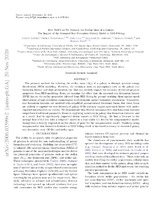How well can we measure the stellar mass of a galaxy: The impact of the assumed star formation history model in SED fitting

View/
Date
2020Author
Dave´, Romeel
Lower, Sidney
Narayanan, Desika
Metadata
Show full item recordAbstract
The primary method for inferring the stellar mass (M∗) of a galaxy is through spectral energy distribution (SED) modeling. However, the technique rests on assumptions such as the galaxy star formation history and dust attenuation law that can severely impact the accuracy of derived physical properties from SED modeling. Here, we examine the effect that the assumed star formation history (SFH) has on the stellar properties inferred from SED fitting by ground truthing them against mock observations of high-resolution cosmological hydrodynamic galaxy formation simulations. Classically, SFHs are modeled with simplified parameterized functional forms, but these forms are unlikely to capture the true diversity of galaxy SFHs and may impose systematic biases with under-reported uncertainties on results. We demonstrate that flexible nonparametric star formation histories outperform traditional parametric forms in capturing variations in galaxy star formation histories, and as a result, lead to significantly improved stellar masses in SED fitting. We find a decrease in the average bias of 0.4 dex with a delayed-τ model to a bias of just under 0.05 dex for the nonparametric model. Similarly, using nonparametric star formation histories in SED fitting result in increased accuracy in recovered galaxy star formation rates (SFRs) and stellar ages.
